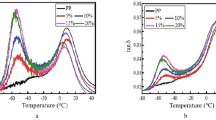Abstract
For the first time the intrinsic tensile stress-strain behaviour of polystyrene was measured in an inert atmosphere (He) from 77 to 350 K. The intrinsic tensile strength decreases monotonically with increasing temperature with completely brittle behaviour below 231 K and crazing without shear flow at higher temperatures. The behaviour in N2, Ar, CH4, CO2, H2S, and N2O was observed with the relative pressure being the important parameter. The softening depended on the square root of the relative pressure. A calculation was made of the concentration of absorbed gas to produce a given amount of softening. The question of why polystyrene is a brittle solid and thus crazes instead of shear flows is discussed.
Similar content being viewed by others
References
J. Hoare andD. Hull,J. Mater. Sci. 10, (1975) 1861.
S. Rabinowitz andP. Beardmore,CRC Crit. Rev., Macromol. Sci., Jan (1972) 1.
A. Hiltner, J. A. Kastelic andE. Baer, in “Advances in Polymer Science and Engineering” edited by K. D. Pae, R. D. Morrow and Yu Chen, (Plenum Press, New York, 1972) p. 335.
H. G. Olf andA. Peterlin,J. Polym. Sci. Polymer Phys. Ed.,12 (1974) 2209.
N. Brown andY. Imai,J. Appl. Phys. 46, (1975) 4130.
Y. Imai andN. Brown,Polymer,18 (1977) 298.
Idem, J. Mater. Sci. 11 (1976) 419.
S. Fischer andN. Brown,J. Appl Phys. 44 (1973) 4322.
J. B. C. Wu andN. Brown,Mater. Sci. And Eng. 44 (1980) 121.
G. J. Van Amerongen,Rubb. Chem. Technol. 37 (1964) 1065.
V. Stannett, in “Diffusion in Polymers” Edited by J. Crank and G. S. Park (Academic Press, London and New York Chap. 2.
J. H. Hildebrand andR. L. Scott, “The Solubility of Nonelectrolytes” (Dover Publications, New York, 1964) p. 134.
P. J. Flory, “Principles of Polymer Chemistry” (Cornell University Press, Ithica, New York, 1953) p. 495
A. S. Argon, J. G. Hanook andM. M. Salama,Fracture 1 (1977) ICF 4 p. 445.
E. J. Kramer,J. Mater. Sci. 14 (1978) 1381.
E. Smith, “The Mechanics and Physics of Fracture” (The Metals Society, London, 1975) p. 47.
S. T. Wellinghoff andE. Baer,J. Appl. Polymer. Sci. 22 (1978) 2025.
N. Brown,J. Macromol. Sci. Phys. B19 (3) (1981) 387.
Y. Imai andN. Brown,J. Polymer. Sci. 14 (1976) 723.
F. Din (ED) “Thermodynamic Functions of Gases”, Vol. 3 (Butterworths, London, 1962) p. 72.
D. W. Van Krevlen, “Properties of Polymers”, 2nd edn. (Elsevier, Amsterdam, 1976).
Author information
Authors and Affiliations
Rights and permissions
About this article
Cite this article
Wu, J.C.B., Brown, N. The tensile stress-strain behaviour of polystyrene in inert and gaseous environments. J Mater Sci 17, 1311–1319 (1982). https://doi.org/10.1007/BF00752240
Received:
Accepted:
Issue Date:
DOI: https://doi.org/10.1007/BF00752240




